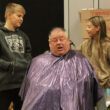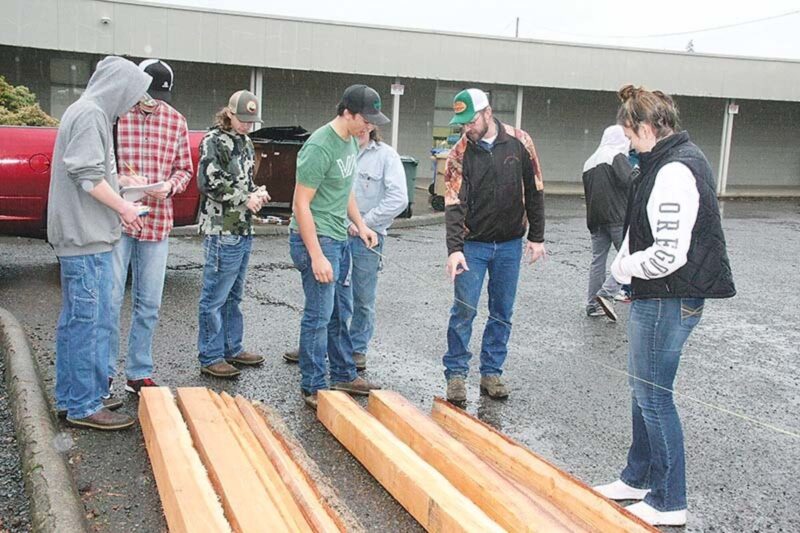Sean C. Morgan
A new career and technical education program at Sweet Home High School is giving students a glimpse into what their community is all about, possible career paths and concrete applications of skills they’ve been learning in the classroom for most of their lives – and it’s helping in forestry competitions.
The natural resources program, taught by Blake Manley, provides a hands-on experience for high school students in a variety of activities.
Thursday morning, Dec. 20, they milled a log and spent time figuring out how many board feet the log actually produced.
“I just feel like it’s a lot about Sweet Home,” said junior Iakona Howerton. He said he’s not interested in a forestry career. He wants to be a pilot. But he finds the subject, with Sweet Home’s timber heritage, interesting.
“Math is probably my strongest subject,” Howerton said, but he enjoys “applying math in the (real) world.”
“It’s kind of basic math we had a couple of years ago,” said junior Kai Bryson, echoing the thought about applying it to real-world activities.
“My whole family, they’re a logging family from Sweet Home,” Bryson said. “I thought it would be fun to learn.”
He’s interested in natural resources, he said. He’s not sure what he wants to do after graduation, “but I’d love one day to have a tree company.”
Senior Zech Brown, who is thinking about a career in forest management, has been a member of the school’s Forestry Club for four years, and he is serving a student assistant in the natural resources class. As an assistant, he’s still learning.
“This is more toward the technical side,” Brown said. “That’s where we’ve been getting killed in the (forestry) competitions.”
Sweet Home has improved 100 percent in technical events, Brown said. “This is hands-on every day.”
Brown plans to work an internship, cruising timber in the summer, he said. After that, it may turn into a full-time position.
“It’s kind of cool to see different jobs,” said sophomore Rebecca Belcher. “Most kids don’t get” the interaction with professionals and the hands-on experience, a preview into careers in natural resources.
Many types of careers are available in natural resources, she said.
It’s a lot more than being a logger, Brown said. Business, management and buying and selling, are key parts of it.
But students also pick up skills, such as interviewing for a job, that are useful anywhere, Belcher said.
It builds confidence, Brown said, noting how the program has helped another student come out of a shell.
“You can tell, she’s a lot more open with people,” Brown said. She’s “out shaking hands.”
With all the practical experience and time working with people in industry, kids in programs like this and the Future Farmers of America “are used to talking in front of people,” Manley said.
“I like that they’re (the School District) trying some more things,” Belcher said. The students still have to take their core classes, but she is happy the district is providing things like the natural resources program as well.
“We’ve done a couple of field trips,” Manley said. The first was “Live in the Woods” with the Oregon Forest Resources Institute. Natural resources students went to Oregon State University’s McDonald Forest, north of Corvallis, where they got to see equipment used in the industry. Cascade Timber Consulting President Milt Moran was among presenters there.
The students have taken two trips to Weyerhaeuser’s Santiam Lumber mill between Sweet Home and Lebanon. The first was to the yard, where they learned about log scaling and other mill yard work. The second time, they toured the interior, which is mostly automated.
“We’re reaching out to kids” about the possibilities, Manley said. “It’s not just about being a logger. It’s not just about flipping a board. This first year, we’re working out some of the kinks, but it’s good stuff. I think we’re significantly better off than we were Sept. 1. The trajectory is upward.”
The program drew 96 students during the fall term, which included a fisheries class, a forestry skills class and a natural resources classes.
The winter term has 62 students enrolled in two natural resources classes and Introduction to Forestry.
During spring term, Manley will teach a forest products class,which is more geared toward what it takes to turn a tree into a product. The class will feature a tour of an area paper mill.
Manley said he and the school are developing a program for second-year students, with more advanced classes. Activities may include cruising all of Sankey Park or helping local loggers in the forests.
“That’s how we engage the kids who want to be here,” Manley said, and they build a passion for forestry.
Students in CTE programs are substantially more likely to graduate than the general high school population, according to state records.
It can make a difference for students who might not graduate if this program didn’t exist, Manley said.
Funding for the program is derived from Measure 98 of 2016, which provided funding dedicated to increasing graduation rates and CTE programs.
“I’ve got two or three I think honestly have shown interest that are going to move a lot closer to graduation because of a class like this,” Manley said. “If they’ll put their noses down, they’ll graduate on time because of classes like this.”
A wide variety of activities can capture students’ attention, he said. They learn to use a variety of tools.
One girl in the class latched onto using a compass. She enjoys hunting and the outdoors, and learning how to properly use a compass to navigate fascinated her.
It’s all practical, from the math to the compass, he said. Students will cut firewood for sale. The sale will go toward doing something fun, and that interests the students.
In one class segment, Manley outlined how intertwined forestry is with Sweet Home’s economy, from the logger to the tire center that puts wheels on the trucks to the mills and all of the people those impact.
Manley said the program doesn’t offer science credit except in fisheries, which he teaches directly based on another teacher’s curriculum. The class content is much broader than forestry and can range across a variety of areas of scientific interest, from climate change and producing energy to Canadian shale oil.
High school administrators want to provide science credits with the program, he said, and he is working with them to figure out how to do that. He may partner with more teachers to provide that credit, or he may work on certification.
The goal is to have more science credits offered one way or the other within five years, he said. First, he must complete his CTE certification, which is a three-year deadline. After that, he may seek science certification.
In addition to classwork, Manley coaches a forestry team in competitions that are called “career development events.”
The team has 17 students who have now competed in two pre-season events. At Tillamook, the team placed first in all three individual awards, with Christian Black named Best Jack; LaceAnna Shiffert winning Best Jill and Best Technical Forester. The team placed first, ahead of Clatskanie and Knappa.
The team won the individual awards at Scio, Black as overall Jack and Belcher as overall Jill, but placed second overall because it didn’t have enough members scoring points to beat Clatskanie.
The team has four regular season events, March 2 at Knappa, March 9 at home, March 16 at Philomath and April 6 at Clatskanie. State is April 20 and April 21.





